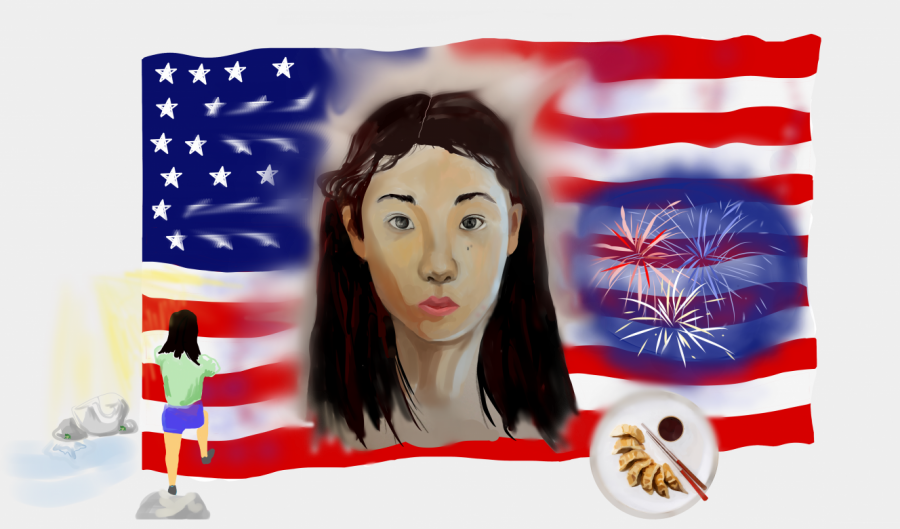This land was made for you and me?
My Asian American identity is composed of traditions from both my heritage and nationality. Whether it be watching fireworks on the Fourth of July, eating dumplings on Lunar New Year or spending summers in my grandparents’ complex in Xi’an, I carry both cultures with me.
Whenever I travel to a foreign country, my American passport tells my identity. Gold eagle stamped on navy blue. Carrying it to visit relatives in China for weeks at a time, I spoke English with my sister to distinguish myself as American. I, with my childish pride, knew exactly what I was: American. And therefore, despite our similar physical features and cultures, I was pointedly different from the other children I caught frogs and tadpoles with over the summer.
I love the familiarity of touching down on the airport runway. I love breezing past the endless line for foreign arrivals. Most of all, I love the crisp stamp and a “Welcome home!” from the U.S. customs agent.
Growing up in Silicon Valley, I didn’t need to look hard for familiar Asian faces in the media. There was a lawyer, there was a CEO, there was an English teacher, there were boundless opportunities. I watched the Spring Festival Gala broadcast on Chinese television during Lunar New Year, munching on a plate of dumplings, and drove up to San Francisco five months later to cheer with strangers, united under fireworks on the Fourth of July.
In that crowd, picture an American. Picture a Chinese person. Now, picture a girl, a product of these two cultures, sitting on a roof with a smile stretching so wide her cheeks hurt as the night rumbles awake in bursts of red, white and blue. The dark hides her black hair, her black eyes, her tinted skin. It hides how eyeshadow refuses to pack into the crease of her upper lid as YouTube videos demonstrate, but her silhouette against the sky is the silhouette of a patriot.
But what does it take to throw off stereotypes and be seen as patriotic by other citizens, or by the president of my country? His Twitter designation of COVID-19 as the “Chinese Virus” makes this particularly difficult. Though the logic behind calling the virus “Chinese” would link it to the initial cases reported in Wuhan, as China was the first to weather the pandemic, this rationale fails to account for how the term “Chinese Virus” actually translates to society, where fear and confusion offer up Asian-Americans as an easy target for hate crimes.
Even with the large Asian-American population in the Bay Area, fear and unjustified hatred is no further than the local community, where five Asian-owned businesses were left with shattered glass doors and windows in April.
In addition to largely ignoring the personal impacts of racist dialogue, President Donald Trump has temporarily halted the distribution of green cards for living and working in the U.S., notably preventing immigrants from joining their families. This policy, which went into place on April 23 and lasted for 60 days, came with the president’s declaration on Twitter that the suspension is a result of the “need to protect the jobs of our GREAT American Citizens.”
His belief that foreign-born populations drag down the economy is false. Studies show that native-born citizens participate in the labor force at a lower rate than immigrants, who hold down a large sector of jobs not requiring a college degree, professions which have become increasingly essential during the pandemic. Despite these conflicting statistics, the president proceeded with an immigration ban, capitalizing on the current climate of xenophobia to cement anti-Asian policies.
In such an environment, it is easy to forget that Asian-American entrepreneurs have pioneered products for the 21st century. Zoom founder Eric Yuan heads a video conferencing platform used by schools, businesses and even friendly gatherings during the current shelter-in-place order. Yahoo, a company co-founded by Taiwanese-American programmer Jerry Yang, led the way during the onset of the Internet.
From NVIDIA, a company co-founded by Taiwanese-American Jensen Huang and whose processing units provide services to gaming software such as Minecraft, to John Tu and David Sun, who created memory storing technology such as USB’s and hard drives, Asian American leadership has paved the road of innovation, and should not be forgotten in favor of misplaced fear.
Calling COVID-19 the “Chinese Virus” blames a whole culture, their descendants and others who resemble their physical appearance for the pandemic. The generalization of the disease is a careless stigmatization of all Asian-Americans, and a quick Google search pulls up videos of those of East Asian descent chased with spray bottles, berated on public transportation, criminalized for coughing or waking up to a vehicle vandalized with racial slurs.
Not every Chinese-American has COVID-19, and not everyone who has tested positive is of Chinese descent. Not only are viruses blind to ethnicity, but the Chinese American community has also gone to great lengths to support local hospitals, donate masks and even 3D print face shields for doctors and nurses.
There is a distinct difference between donating out of will and donating as a plea to be accepted as American. Former Democratic presidential candidate Andrew Yang has weighed in on this topic with his opinion article published in the Washington Post on April 1, which encourages Asian Americans to “show our American-ness in ways we never have before,” and suggests that the community “wear red white and blue” in order to “show without a shadow of a doubt that we are Americans who will do our part for our country.” He says that due to their ethnic heritage, Asian Americans must vigorously volunteer, enthusiastically wave flags, spin their tale into one of diehard patriotism, just to grasp at what their neighbors inherently possess, the title of “American.”
By encouraging Asian-Americans to do more to show their patriotism, Yang reinforces the idea that hyphenation does not mean fully American or fully patriotic, but instead connotes a degree of separation from what it means to be American. This gap that should not exist nevertheless does.
Looking back at history and at Yang’s words, Asian-Americans have long had to participate in this show of “American-ness.” After the unexpected attack on Pearl Harbor on Dec. 7, 1941, Asian-Americans desperately needed to distinguish between the two parts of their hyphenation. Their heritage was Asian, but they were American. White fear of internal enemies strengthened, and the country’s mindset was geared toward — often irrationally — pointing out “aliens” among the population.
The American public and government hurled undeserving retributions at Japanese Americans, accusing them of supporting the Japanese government. In the name of “military necessity,” 120,000 Japanese Americans, from adults to infants and mostly from the Pacific mainland, were removed from familiar sidewalks and loved hometowns to barren barracks furnished with Army cots and barbed wire fences.
Asian-American heritage led to integration for some and inferiority for others. As Ronald Takaki, a American author and former Professor of Ethnic Studies at UC Berkeley, writes in “Strangers from a Different Shore,” acknowledging diversity “would require a critical scrutiny of American society and would expose the contradictions within,” particularly in who was allowed to be “American.”
If I stood out due to my American nationality during childhood summers in China, and if neighbors of the same nationality now solely regard me by my heritage, looking past my passport without a thought, where do I belong? I should be able to use chopsticks and speak in Mandarin and have pride in my heritage without compromising my identity as an American citizen.
Chinese immigrants have toiled tirelessly for America. They endured back-breaking labor and uncounted casualties building the Transcontinental Railroad from 1863 to 1869. The 442nd Infantry Regiment, the most decorated military unit in American history composed of mostly second generation Japanese American soldiers, suffered 9,486 casualties during World War II. Even after countless other Asian-Americans have fought for a home in this country, societal narrative easily casts them aside.
It is not the responsibility of Asian-Americans to prove their “American-ness,” and it never should have been. Instead, it is the obligation of society to accept their nationality as it is stated. Even when authority wields the term “Chinese Virus” and debates who is truly American, we as citizens must consciously make the decision to eliminate racial slurs from the narrative. Easy steps are to use the scientific term coronavirus or COVID-19, to stop pulling up eyelids to mock Asian features and to understand that nationality extends beyond a hyphenation.
To all Asian-Americans out there, own your nationality and proudly acknowledge who you are. Refuse to be distracted, and keep staying inside, donating masks, printing face shields, supporting local businesses and doing all that you do. The burden of proving your nationality is not on you.
Now, picture an American.

Nicole Tian (12) is the co-editor-in-chief of Harker Aquila. This is her fourth year on staff, and she previously served as the opinion editor, co-lifestyle...


















![“[Building nerf blasters] became this outlet of creativity for me that hasn't been matched by anything else. The process [of] making a build complete to your desire is such a painstakingly difficult process, but I've had to learn from [the skills needed from] soldering to proper painting. There's so many different options for everything, if you think about it, it exists. The best part is [that] if it doesn't exist, you can build it yourself," Ishaan Parate said.](https://harkeraquila.com/wp-content/uploads/2022/08/DSC_8149-900x604.jpg)




![“When I came into high school, I was ready to be a follower. But DECA was a game changer for me. It helped me overcome my fear of public speaking, and it's played such a major role in who I've become today. To be able to successfully lead a chapter of 150 students, an officer team and be one of the upperclassmen I once really admired is something I'm [really] proud of,” Anvitha Tummala ('21) said.](https://harkeraquila.com/wp-content/uploads/2021/07/Screen-Shot-2021-07-25-at-9.50.05-AM-900x594.png)







![“I think getting up in the morning and having a sense of purpose [is exciting]. I think without a certain amount of drive, life is kind of obsolete and mundane, and I think having that every single day is what makes each day unique and kind of makes life exciting,” Neymika Jain (12) said.](https://harkeraquila.com/wp-content/uploads/2017/06/Screen-Shot-2017-06-03-at-4.54.16-PM.png)








![“My slogan is ‘slow feet, don’t eat, and I’m hungry.’ You need to run fast to get where you are–you aren't going to get those championships if you aren't fast,” Angel Cervantes (12) said. “I want to do well in school on my tests and in track and win championships for my team. I live by that, [and] I can do that anywhere: in the classroom or on the field.”](https://harkeraquila.com/wp-content/uploads/2018/06/DSC5146-900x601.jpg)
![“[Volleyball has] taught me how to fall correctly, and another thing it taught is that you don’t have to be the best at something to be good at it. If you just hit the ball in a smart way, then it still scores points and you’re good at it. You could be a background player and still make a much bigger impact on the team than you would think,” Anya Gert (’20) said.](https://harkeraquila.com/wp-content/uploads/2020/06/AnnaGert_JinTuan_HoHPhotoEdited-600x900.jpeg)

![“I'm not nearly there yet, but [my confidence has] definitely been getting better since I was pretty shy and timid coming into Harker my freshman year. I know that there's a lot of people that are really confident in what they do, and I really admire them. Everyone's so driven and that has really pushed me to kind of try to find my own place in high school and be more confident,” Alyssa Huang (’20) said.](https://harkeraquila.com/wp-content/uploads/2020/06/AlyssaHuang_EmilyChen_HoHPhoto-900x749.jpeg)




